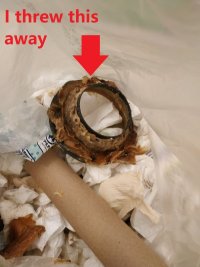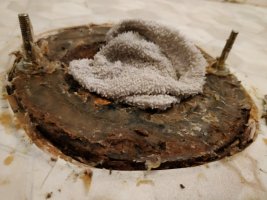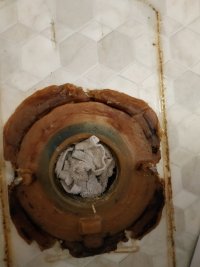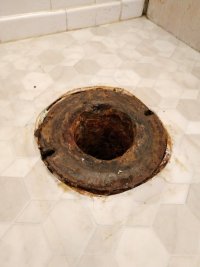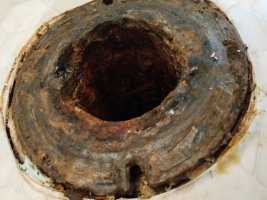Harold Balls
Member
Hello, Terry and friends!
As a DIY’er, I’ve got another infrequent (seemingly biannual) toilet install. Facts: 1957 house. Old cast iron drainpipe might be the old 3.5-inch; I didn’t measure it and am not at the location now. Unfortunately, I did not take more photos, either, after I finished cleaning the old cast iron flange and removing the old flange bolts. If it matters, this is probably the third toilet that has sat on the same flange (if it truly is the original flange). A second toilet was likely installed in 1979 for a remodel, and the current pink Kohler K-4493 1.6 gpf comfort-height appears to have a date-stamp of 2002. I’m tossing it and installing a used white Kohler elongated 1.6 gpf for a remodel and then to subsequently rent out the house.
Problems (see photos):
As a DIY’er, I’ve got another infrequent (seemingly biannual) toilet install. Facts: 1957 house. Old cast iron drainpipe might be the old 3.5-inch; I didn’t measure it and am not at the location now. Unfortunately, I did not take more photos, either, after I finished cleaning the old cast iron flange and removing the old flange bolts. If it matters, this is probably the third toilet that has sat on the same flange (if it truly is the original flange). A second toilet was likely installed in 1979 for a remodel, and the current pink Kohler K-4493 1.6 gpf comfort-height appears to have a date-stamp of 2002. I’m tossing it and installing a used white Kohler elongated 1.6 gpf for a remodel and then to subsequently rent out the house.
Problems (see photos):
- The flange is in fair shape (see photos), but sturdily holds the flange bolts in place. Do I need to repair it with this or just leave it alone? -- https://www.homedepot.com/p/Flexon-...-ABS-Cast-Iron-or-Lead-Pipes-PB-204/315567006.
- I removed a plastic gasket/sheath that sat on top of the flange and inside of the pipe. I tossed it; do I need another? What was it? I’m planning to use only this - https://www.homedepot.com/p/Korky-Wax-Free-Toilet-Seal-Kit-6000BM/205616926.


